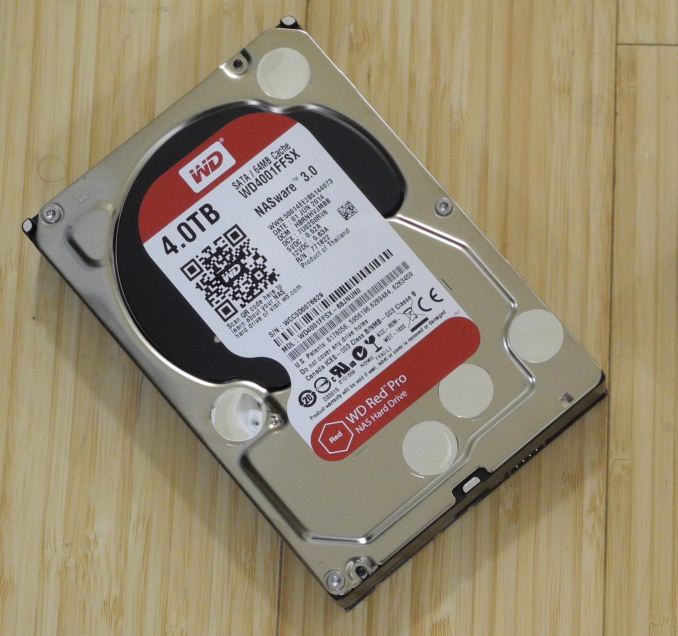WD Red Pro Review: 4 TB Drives for NAS Systems Benchmarked
by Ganesh T S on August 8, 2014 9:00 AM ESTConcluding Remarks
Ten different 4 TB hard drives have been analyzed for NAS and DAS applications. Coming to the business end of the review, it is clear that there is no 'one size fits all' model in this area. The hard drives themselves were launched targeting different markets and their resulting performance varies accordingly. However, based on our test results we can arrive at the following conclusions:
The lowest power consumption numbers were recorded, as expected, with the 5400/5900 RPM drives: the WD Reds, Seagate NAS HDDs and the Seagate Terascale units. While the WD Red drew the least power in the resync test, the Terascale and the NAS HDD drew less power during our access sequence tests (though not by much). If power constraints are a primary factor any one of the three would be a good choice. However with that said, despite possessing the highest workload rating of the three the Terascale has the lowest MTBF, coming in at a rating of 800K hours versus 1M hours for the Western Digital and Seagate NAS drives. Consequently depending on the usage scenario the extra premium for the Terascale might not be worth it.
The best overall performance is recorded by the Seagate Enterprise Capacity v4, thanks to its clear lead in the random access patterns segment of the multi-client evaluation. The drawback being that the part is quite difficult to come across for purchase and carries a premium wherever it becomes available.
Meanwhile the Toshiba drive is a strong value proposition as the cheapest enterprise hard drive in the scalable storage class of drives. Even though the MSRP and street price put it in the same category as that of the Seagate Terascale, we have seen occasional deals which give it only a slight premium over the non-enterprise WD Red and the Seagate NAS HDDs. Otherwise the Ultrastar 7K4000 SAS unit is also available for rock bottom prices from third-party sellers on Amazon, and is a good candidate for users running SAS-based storage servers. Though without a broader sample space it is difficult to recommend it further.
Finally we have the WD Red Pro, which aims to strike a balance between performance, power consumption and price. The attractive pricing (given the warranty) makes up for the fact that it doesn't impress in any particular category compared to the competition. If Seagate's Enterprise Capacity drive were to retail for the same price as that of the Red Pro, the choice would be a no-brainer in favour of the Seagate unit. But right now that is not the case, and Western Digital continues to present a unique value proposition with the Red Pro lineup.
All in all, there are plenty of options for NAS users looking to stock up their NAS units with high capacity drives. Though not at the bleeding edge of capacity, today's 4TB drives offer a good mix of pricing, performance, and capacity; and for the cautious buyer 4TB drives offer an alternative to the potential risk in going the new technology route with 6 TB drives. In the end, with the right data in hand it's easy enough to find the best fit by taking into consideration the expected workload and desired price points.











62 Comments
View All Comments
dzezik - Friday, September 26, 2014 - link
that is why we do not use RAID but ZFS. think about itNavvie - Monday, August 18, 2014 - link
Thanks. Interesting read.colinstu - Saturday, August 9, 2014 - link
bought 4x 4TB SEs last year, at least I'm not missing out on anything!dzezik - Friday, September 26, 2014 - link
are you sure You still have Your data on the disk and not random zeros and ones. how can You be sure without daily scrubbing.HollyDOL - Monday, August 11, 2014 - link
Hi, are the bandwidths in graphs (page 5...) really supposed to be in Mbps (mega-bits per second)? Although it's correct bandwidth unit, the values seem to be really low (fastest tests would be about 30MB/s), the values provided I'd expect to be in MBps for the numbers to correspond...ganeshts - Monday, August 11, 2014 - link
Thanks for catching it. It is indeed MBps. I have fixed the issue.GrumpyOldCamel - Wednesday, August 13, 2014 - link
raid5, seriously?Why are you not focused on reliability, thankfully I see most of the other commentors are making similar points to mine, where did all the 10^16 and 10^17 drives go?
Why are we not exited about the newly leaked 10^18 drive?
When it comes to storage, you can keep size and you can keep speed, Im not interested.
I just want reliability.
Gear8 - Saturday, September 13, 2014 - link
Where measuring the heating ??? Where degrees Celsius ???dzezik - Friday, September 26, 2014 - link
Hey. This test setup is wrong. There is on SAS disk but there is no SAS HBA in the list of test setup. according to other tests benchamarks HGST SAS disk is the fastest from this list but it suffers because of poor or very poor controller. this comparison is worth nothing without good SAS HBA. and remember good HBA also increase SATA disk performance. embedded intel controllers are very simple and limited performance. good SAS HBA is about 150$ so it is not a big deal. regardsKingSmurf - Wednesday, October 22, 2014 - link
Just wondering this review states for the WD Se:Non-recoverable read errors per bits read < 1 in 10^14 and MTBF of 800k
while on WD's Specsheet it says for the Se:
Non-recoverable read errors per bits read < 1 in 10^15 and MTBF of 1 M (800k is the 1 TB only)
Did WD suddenly change the Spec Sheet - or was this review... let's say less than thorough?